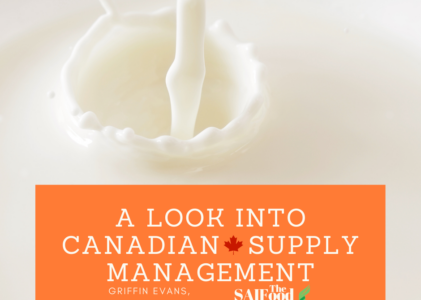By Griffin Evans, University of Saskatchewan
What is Supply Management?
As a Canadian, and as someone dedicated to understanding how our government affects our daily lives, I have become captivated by a policy our government maintains called supply management. Supply management is how the government can limit the production of a product by allocating quotas to Canadian suppliers. In Canada’s case, we have set supply management limits on dairy, poultry, and eggs (Heminthavong, K). To some, Canadian supply management can be extremely beneficial; however, it can do the opposite for others.
The Cause and Effect of Supply Management
I think acknowledging the reason for introducing supply management in opposition to a free market is vital to understanding why it continues to remain in government policy today. In the 1960s, Canadian dairy, poultry, and egg farmers faced overproduction due to technological advancements (Heminthavong, K). This created price instability and caused interprovincial trade disputes. Farmers asked their provincial governments to develop new marketing boards that made supply management in Canada. This new supply management policy allowed farmers to maintain a sustainable income, stopped overproduction, and allowed farmers who could no longer compete, to compete. It has also allowed Canadians to buy mostly local produce as international tariffs are set on these products for importers. So, what is the other side of supply management? Well, in economics, a reduction in supply equates to an increase in consumer price. According to an article in the International Review of Economics, it is estimated that between 130,000 and 190,000 individuals have been pushed below the low-income/poverty threshold due to supply management (Desrochers, P). Another article estimates that low-income households with children pay $466 to $592 extra per year on dairy and poultry due to supply management (Cardwell, R). With low-income families already struggling to get by for the year, that extra money could make a big difference, especially when added up over time.
Another aspect of supply management that I find crucial is it has created a minimal need for innovation. Typically, when one competitor gains an advantage in a competitive market, the other side must innovate to survive. An example of this that seems quite related to supply management is how farmers in Saskatchewan were subsidized by the government and needed to change very little (Warick, J). However, when the government cut this subsidy, innovation flourished. Farmers started growing new types of crops, farms became more extensive, and we began spending more on research and development to continue innovating (Morgan, G). Additionally, when the Canadian Wheat Board was removed, farmers were free to sell their produce anywhere. Restrictions seem to do the opposite of what they initially set out to accomplish.
“Supply management is an outdated relic of government intervention in free markets, akin to the Canadian Wheat Board’s long-time grain monopoly… ending the wheat board’s monopoly gave farmers the freedom to raise whatever crops yielded the best returns. The formerly mono-culture Prairies became a checkerboard of yellow canola, lime-green peas, and a diverse variety of cereal grains. Command and control farming has morphed into high-productivity entrepreneurship.”
A Call to Action
I understand the abolishment of the supply management system in Canada is a controversial topic. I also know that removing supply management would be extremely difficult due to vote pandering and lobbyist behaviour (Goodwin, B). I believe that the best thing for those in the supply-managed sector is the removal of supply management and the implementation of a free market. It is no longer the 1960’s; these technological advancements that held farmers back have made it to farms as they are undoubtedly able to afford it. I believe that a move towards a free market would benefit consumers the most in the short run. Still, in the long run, it will benefit the producers by allowing them to become larger; it will also benefit farm innovation and development. If tariffs are lifted on countries wanting to import to Canada, the price of these supply-managed products will decrease in price for the consumer. Of course, Canadian dairy will still be able to compete with their American counterparts. They will have to adapt and possibly adopt new farming practices. This is part of the innovation that will come from the end of supply management in Canada. The free market will give consumers more choices and cheaper options and give producers the freedom to expand and innovate.
[su_accordion][su_spoiler title=”References” open=”no” style=”default” icon=”plus” anchor=”” class=””][su_list icon=”icon: check” icon_color=”#47907C”]
- Cardwell, Ryan, et al. “Milked and Feathered: The Regressive Welfare Effects of Canada’s Supply Management Regime.” Canadian Public Policy, vol. 41, no. 1, Mar. 2015, pp. 1–14., doi:10.3138/cpp.2013-062.
- Desrochers, Pierre, et al. “Supply Management and Household Poverty in Canada.” International Review of Economics, vol. 65, no. 2, 2018, pp. 231–240., doi:10.1007/s12232-018-0295-x.
- Goodwin, Brett. “To Trade, or Not to Trade: Explaining Lobbying Behaviour in the Canadian Dairy Sector.” University of Calgary, 5 Sept. 2019, prism.ucalgary.ca/bitstream/handle/1880/110907/ucalgary_2019_goodwin_brett.pdf?sequence=5&isAllowed=y.
- Heminthavong, Khamla. Canada’s Supply Management System. 30 Nov. 2018, lop.parl.ca/sites/PublicWebsite/default/en_CA/ResearchPublications/201842E.
- Morgan, Gwyn. “Ending Dairy Supply Management Would Be a Win-Win-Win.” Financial Post, Financial Post, 22 Aug. 2018, financialpost.com/opinion/gwyn-morgan-ending-dairy-supply-management-would-be-a-win-win-win.
- Warick, Jason. “Why It Could Be Time to Reevaluate Sask. Farm Subsidies | CBC News.” CBCnews, CBC/Radio Canada, 14 Mar. 2017, www.cbc.ca/news/canada/saskatoon/farm-subsidies-agriculture-saskatchewan-budget-1.4018441.
[/su_list] [/su_spoiler][/su_accordion]

Griffin Evans
I am from a small town called Bethune, about forty minutes outside of Regina. I come from a family of farmers, and although I don’t plan on becoming one myself, I have a strong connection to agriculture, and nothing makes me feel more at home than being surrounded by it. This year is my third year at the U of S studying Agribusiness. I initially wanted to take my degree in Agricultural Biology but found I had more interest in business than in biology. Another benefit of the Agribusiness degree is the ability to work in and out of the agricultural industry, and I enjoy having that freedom going into the future. As for my future plans, I was offered a fantastic opportunity to work at Nutrien Ag Solutions in Lumsden, Saskatchewan, both in the summers and after graduation. I have no plans beyond that as I like to live one day at a time!


